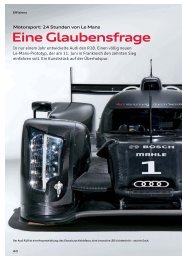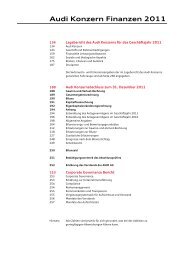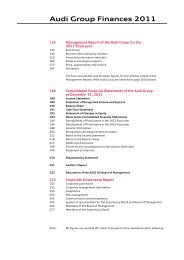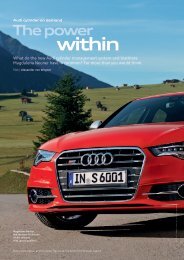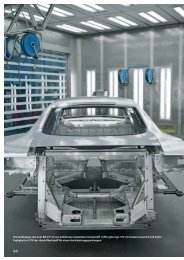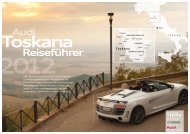In harmony with the environment
In harmony with the environment
In harmony with the environment
Create successful ePaper yourself
Turn your PDF publications into a flip-book with our unique Google optimized e-Paper software.
92 94 _ Responsibility<br />
Rubrik<br />
Sustainability<br />
<strong>In</strong> <strong>harmony</strong><br />
<strong>with</strong> <strong>the</strong> <strong>environment</strong><br />
Many different methods are being used to achieve energy efficiency,<br />
CO₂ reduction and sustainability at Audi. The common denominator<br />
and name for <strong>the</strong>se efforts: Audi balanced mobility.<br />
Text | Kay Dohnke<br />
f o t o s | xxxxxxxxxxxxxxxxxx
Rubrik _ 95<br />
Audi has made an area measuring some<br />
23,000 square meters available for<br />
photovoltaic modules at its <strong>In</strong>golstadt<br />
plant. The car manufacturer is thus<br />
supporting <strong>the</strong> use of various technologies<br />
for harnessing solar energy and in this<br />
way is making a major contribution toward<br />
fur<strong>the</strong>r optimizing solar technology.<br />
p h o t o s | gr e e n city ener g y ag; audi ag<br />
When sustainable<br />
mobility is discussed<br />
<strong>with</strong>in<br />
<strong>the</strong> Audi Group,<br />
it’s about more than just technologies<br />
that reduce a car’s fuel consumption<br />
and <strong>the</strong>refore also reduce emissions –<br />
sustainable mobility is viewed in a<br />
much more comprehensive sense.<br />
“The Company takes its social responsibility<br />
seriously on many levels,” commented<br />
Rupert Stadler, Chairman of<br />
<strong>the</strong> Board of Management of AUDI AG,<br />
describing <strong>the</strong> Company’s philosophy.<br />
“<strong>In</strong> <strong>the</strong> interest of preserving a livable<br />
future for coming generations. <strong>In</strong><br />
addition to international competitiveness<br />
and a forward-looking human<br />
resources policy, <strong>environment</strong>al protection<br />
and preservation of resources<br />
form <strong>the</strong> cornerstones for sustainable<br />
management of <strong>the</strong> Company.”<br />
With this in mind, <strong>the</strong> Company is active<br />
in many fields that go beyond <strong>the</strong><br />
actual product of <strong>the</strong> automobile. The<br />
commitment begins as early as <strong>the</strong><br />
product development process.<br />
“The production area in particular offers<br />
ample potential that we are developing<br />
systematically,” said Frank Dreves,<br />
Member of <strong>the</strong> Board of Management<br />
for Production at AUDI AG. A vehicle’s<br />
<strong>environment</strong>al footprint, after all, also<br />
depends on how it is built, <strong>with</strong> particular<br />
attention being paid to energy. By<br />
2020 Audi wants to reduce site- and<br />
Company-specific CO₂ emissions by<br />
30 percent from <strong>the</strong> level in 1990. The<br />
goal: carbon-neutral car production.<br />
For this, <strong>the</strong> energy required in <strong>the</strong><br />
direct production process will be reduced.<br />
The use of hot-shaped steels in body manufacturing makes it possible to combine low weight <strong>with</strong> high strength.<br />
The CO₂ balance is already positive during production: The energy demand for hot-shaping high-strength steel<br />
produces 20 percent less CO₂ than when using conventional steel.
94 _ Responsibility<br />
Wind power and Audi e-gas<br />
Sustainable energy generation<br />
Audi’s own wind turbines 1 produce renewable electricity. <strong>In</strong> <strong>the</strong> electrolyzer 2, this electricity<br />
is used to split water into hydrogen and oxygen. <strong>In</strong> ano<strong>the</strong>r section of <strong>the</strong> plant 3,<br />
<strong>the</strong> hydrogen is converted into methane by adding CO₂. Audi calls <strong>the</strong> resulting syn<strong>the</strong>tic<br />
natural gas “e-gas.” The CO₂ could be supplied by sources such as a biogas plant 4.<br />
6<br />
4<br />
1<br />
2<br />
3<br />
7<br />
5<br />
Storage and tanking up<br />
Fuel for future drive systems<br />
For transport or storage, <strong>the</strong> syn<strong>the</strong>tic natural gas can be fed into <strong>the</strong><br />
existing natural gas grid 5. It is <strong>the</strong>n available as a fuel at CNG<br />
stations 6. Electric cars can charge up on <strong>the</strong> electricity from <strong>the</strong> wind<br />
turbines directly at <strong>the</strong> charging station 7.<br />
The Audi e-gas<br />
project in miniature.<br />
It is geared toward conserving resources,<br />
<strong>with</strong> significant energy savings made<br />
possible by innovative technologies<br />
such as more efficient robots, new<br />
electric motor-driven welding tongs<br />
and especially light CFRP tools for<br />
body manufacturing. Sometimes even<br />
simple measures can make a crucial<br />
contribution toward achieving a positive<br />
balance: Reprogramming made it<br />
possible for electric hoisting devices<br />
to recuperate as <strong>the</strong>y were lowered<br />
and <strong>the</strong>refore to feed energy back into<br />
<strong>the</strong> power grid. And while engines are<br />
running on test stands, <strong>the</strong>y produce<br />
electricity through generators for <strong>the</strong><br />
plant power grid.<br />
The process chain during automotive<br />
production is energy-efficient<br />
as well: lightweight construction<br />
materials such as aluminum and<br />
carbon fiber-reinforced polymer (CFRP)<br />
as well as <strong>the</strong> use of hot-shaped<br />
steels reduce a car’s weight and <strong>the</strong>refore<br />
its consumption throughout its<br />
entire lifecycle.<br />
The Audi balanced mobility concept,<br />
which is designed for energy efficiency<br />
and <strong>environment</strong>al conservation, is<br />
increasingly being integrated into <strong>the</strong><br />
workforce, according to Dreves:<br />
“The number of suggestions in our<br />
internal improvement system for avoiding<br />
emissions and protecting <strong>the</strong><br />
<strong>environment</strong> has increased significantly –<br />
for improving ambient air, for instance,<br />
or preparing rechargeable batteries for<br />
screwdrivers.” Audi balanced mobility<br />
has a consistent focus on people, which<br />
is why <strong>the</strong> Company is particularly<br />
By 2020, Audi wants to<br />
reduce its site- and<br />
Company-specific CO₂<br />
emissions by 30 percent.<br />
committed to improving ergonomic<br />
conditions at <strong>the</strong> workstations.<br />
Clever minds can continuously find<br />
potential for savings where it may not<br />
immediately be obvious – such as in<br />
logistics, where a software program<br />
calculates <strong>the</strong> optimal use of space in<br />
packaging and containers. By helping to<br />
avoid energy-consuming transport, this<br />
increases <strong>the</strong> potential for saving energy<br />
to up to 20 percent. Great potential for<br />
saving energy has also been developed<br />
in <strong>the</strong> area of distribution logistics: Audi<br />
models shipped overseas from Emden<br />
arrive at <strong>the</strong> port <strong>the</strong> carbon-neutral way<br />
in <strong>the</strong> “Eco Plus” commercial transport<br />
trains of DB Schenker Rail – accounting<br />
for a total of 150,000 cars per year. The<br />
additional costs for <strong>the</strong> green electricity<br />
that is used are borne by AUDI AG. Up<br />
to 70 percent of all cars produced are<br />
transported to <strong>the</strong>ir destinations by rail.<br />
Numerous measures are bringing <strong>the</strong><br />
Audi Group closer to <strong>the</strong> goal of climateneutral<br />
car production. “Emissions<br />
will never be reduced to zero, however,”<br />
Dreves explained. “The unavoidable<br />
emission of CO₂ is <strong>the</strong>refore increasingly<br />
being offset.”<br />
Regarding <strong>the</strong> car itself as a product:<br />
Along <strong>with</strong> making continuous improvements<br />
to <strong>the</strong> efficiency of conventional<br />
m o d e l | ihlenfeld & b e r k e f e l d gmbh p h o t o s | ger a l d bucher/ t a n k management; audi ag<br />
Fuel consumption and emission figures at <strong>the</strong> end of <strong>the</strong> Annual Report
drive systems, Audi is also currently<br />
field-testing innovative drive systems<br />
and fuels under realistic conditions in<br />
three test series. These could help lower<br />
emissions during driving. The prototype<br />
Audi Q5 HFC draws its energy from a<br />
fuel cell and tanks up on hydrogen. The<br />
batteries for Audi A1 e-tron cars <strong>with</strong> an<br />
electric drive system, which are currently<br />
being driven in fleet trials in Munich,<br />
can be conveniently charged from <strong>the</strong><br />
electricity grid. And <strong>the</strong> Audi A3 TCNG,<br />
which will begin rolling off <strong>the</strong> assembly<br />
lines in late 2013, can fill up at any<br />
natural gas fueling station.<br />
Still, <strong>the</strong> Audi Group believes that it is<br />
not enough merely to develop innovative<br />
automotive drive systems to <strong>the</strong> point<br />
where <strong>the</strong>y are ready to use and <strong>the</strong>n<br />
introduce <strong>the</strong>m to <strong>the</strong> market. As a<br />
carmaker that thinks systematically,<br />
Audi also has to keep an eye on having<br />
an appropriate energy supply. This is why<br />
Audi balanced mobility also includes<br />
<strong>the</strong> e-gas project, in which excess wind<br />
power is used to produce hydrogen and<br />
The major strength<br />
of <strong>the</strong> e-gas project:<br />
<strong>the</strong> infrastructure<br />
already exists.<br />
syn<strong>the</strong>tic methane. This should make<br />
carbon-neutral mobility possible.<br />
“At this moment we are realizing a<br />
system that should make climate-neutral<br />
driving possible for owners of Audi<br />
models that run on electricity, hydrogen<br />
or natural gas,” explained project manager<br />
Reiner Mangold. The goal: cars that<br />
drive <strong>with</strong> wind or solar power. Efforts<br />
to implement this concept are based on<br />
familiar technologies. With <strong>the</strong> aid of<br />
electricity, water is split into oxygen and<br />
hydrogen in an electrolyzer. And by<br />
adding carbon dioxide, hydrogen can be<br />
converted into methane, which has <strong>the</strong><br />
same properties as natural gas. Thus,<br />
it can be liquefied, transported through<br />
pipelines, stored in caverns or tanks,<br />
converted into electricity or used for<br />
heating. It can also be used as a fuel<br />
for cars. “So thanks to this technology,<br />
<strong>the</strong>re are three energy sources of <strong>the</strong><br />
future available simultaneously,”<br />
Mangold emphasized: electricity, hydrogen<br />
and syn<strong>the</strong>tic natural gas – known<br />
at Audi as e-gas. Plus, <strong>the</strong>re is ano<strong>the</strong>r<br />
special advantage: if you begin <strong>the</strong><br />
methanization process <strong>with</strong> electricity<br />
produced from renewable resources and<br />
add, for instance, CO₂ from a biogas<br />
plant – which would o<strong>the</strong>rwise reach<br />
<strong>the</strong> atmosphere directly as emissions –<br />
<strong>the</strong> syn<strong>the</strong>tic methane produced in this<br />
way is climate-neutral when used as a<br />
fuel for cars.<br />
Toge<strong>the</strong>r <strong>with</strong> <strong>the</strong> company SolarFuel<br />
GmbH, AUDI AG decided in May 2011<br />
to establish <strong>the</strong> world’s first industrialscale<br />
experimental plant. The plant,<br />
being developed in <strong>the</strong> town of Werlte<br />
in Lower Saxony, is planned to produce<br />
about 1,000 tons of e-gas annually<br />
in <strong>the</strong> next few years – which will<br />
enable 1,500 A3 TCNG cars to travel<br />
15,000 kilometers each per year.<br />
Ano<strong>the</strong>r 150 tons of e-gas can also be<br />
used in <strong>the</strong> public power grid for o<strong>the</strong>r<br />
purposes, such as for <strong>the</strong> production<br />
of electricity during low-wind periods.<br />
The plant in Werlte is one link in a<br />
comprehensive chain of energy production:<br />
It will acquire <strong>the</strong> renewable<br />
electricity from Audi wind turbines in<br />
<strong>the</strong> North Sea offshore wind farm.<br />
Electricity for operating <strong>the</strong> Audi e-tron<br />
can <strong>the</strong>n be obtained directly from <strong>the</strong><br />
power grid. The hydrogen that is produced<br />
through electrolysis is converted<br />
into e-gas and fed into <strong>the</strong> existing<br />
natural gas grid. Mangold sees an<br />
“enormous inherent advantage” here<br />
over hydrogen: “The natural gas distribution<br />
network already exists. This<br />
makes energy-consuming transport and<br />
intensive investment unnecessary.”<br />
Mangold highlights yet ano<strong>the</strong>r major<br />
strength of <strong>the</strong> e-gas project: “There’s<br />
no need to place our hopes on tomorrow;<br />
<strong>the</strong> infrastructure already exists.”<br />
As soon as <strong>the</strong> plant in Werlte begins<br />
operation, owners of an A3 TCNG will be<br />
offered <strong>the</strong> option to acquire e-gas.<br />
The volume of natural gas <strong>the</strong>y use to<br />
tank up <strong>the</strong>ir cars will be compensated<br />
for by feeding <strong>the</strong> corresponding<br />
amount of e-gas into <strong>the</strong> grid. Its use as<br />
a fuel will <strong>the</strong>n be allocated through a<br />
balancing group method. This will make<br />
climate-neutral driving a reality.<br />
Expedition on a 1:87 scale:<br />
learn more about <strong>the</strong> Audi<br />
e-gas project in miniature.<br />
“We have<br />
to continuously<br />
think outside<br />
<strong>the</strong> box.”<br />
Frank Dreves<br />
Production<br />
Sustained success is not only<br />
defined by positive growth<br />
in <strong>the</strong> key financial figures –<br />
it is also defined above all by<br />
<strong>environment</strong>al responsibility.<br />
We’ve been setting an example<br />
in this area for a long time –<br />
not because we have to, but<br />
because we feel an obligation<br />
to do so. We do not wait for<br />
external pressure – <strong>the</strong> best<br />
ideas at Audi come from internal<br />
sources. This is <strong>the</strong> pioneering<br />
spirit that has made our<br />
company what it is today –<br />
and it is what continues to<br />
drive us. It is also behind our<br />
commitment to <strong>the</strong> <strong>environment</strong>.<br />
One of my goals is to<br />
neutralize CO₂ emissions<br />
at our corporate sites. We<br />
are achieving this by forging<br />
new paths, researching new<br />
technologies and continuously<br />
thinking outside <strong>the</strong> box.<br />
We need energy to produce<br />
cars. But we can ensure that<br />
we acquire this energy in<br />
an <strong>environment</strong>ally compatible<br />
way. We have already realized<br />
numerous projects at <strong>the</strong><br />
<strong>In</strong>golstadt site alone. Efficient<br />
solutions such as using waste<br />
heat, heat recovery systems<br />
and trigeneration plants have<br />
proved effective for many<br />
years now. We are continuing<br />
down this path <strong>with</strong> determination<br />
– <strong>with</strong> ideas that,<br />
like Audi itself, might be<br />
considered a bit “different.”



